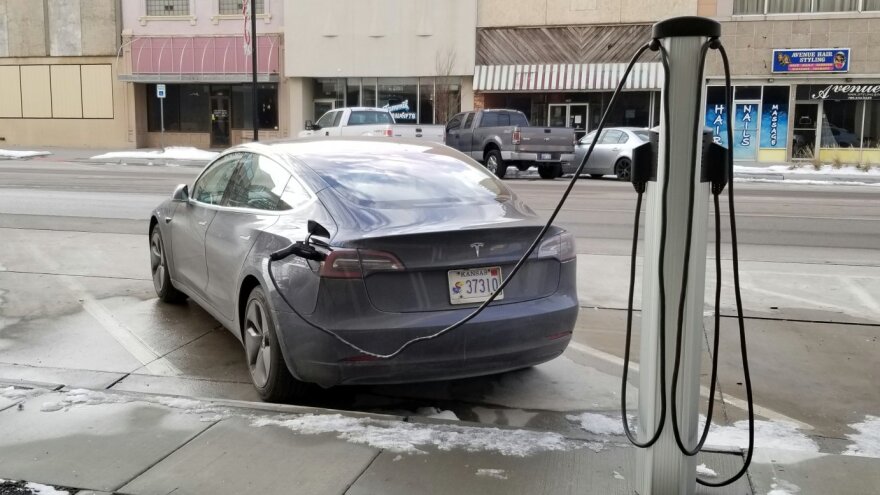Fill ’er up
Pavement wears down at the same rate whether the cars and trucks rolling over it rely on internal combustion engines for locomotion or on new-fangled hybrid and electric motors.
Yet Kansas, like most other states, relies on gasoline taxes for much of the cost of building its roads and keeping them in reasonable shape.
So now, reports Stephen Koranda, a panel of state officials is considering added fees for those vehicles that hit that gas pump less often or skip it entirely.

“There is wear and tear on the highway system from those vehicles, but yet they don’t contribute by purchasing fuel to pay for the gas tax,” state Rep. Troy Waymaster told Koranda.
Legislators might ultimately also consider a tax based on the number of miles a vehicle travels on Kansas roads. That’s something many states have looked at, but the idea has drawn criticism from privacy advocates because tracking a driver’s miles means tracking their whereabouts.
Whole lot o’ shakin’ goin’ on
Research in Kansas had already shown a correlation between oil and natural gas drilling operations that pump wastewater into the ground.
Now new findings by the Kansas Geological Survey suggest wastewater disposal could cause earthquakes farther away than previously thought. The state agency found injection wells can be linked to temblors up to 55 miles away.
J. Schafer of Kansas Public Radio reports that both the link to earthquakes and the amount of fluid injected along both sides of the Kansas-Oklahoma state line are unprecedented. The new research also hints that it can take months, or years, for an injection well to trigger an earthquake.
Feds and families
Next year, the federal government will match money put up by states to help out troubled families and spare their children from the devastation of landing in foster care.
Child welfare advocates have pushed for Kansas to spend at least $30 million dollars. That would do two things: bring spending on family preservation efforts in Kansas more in line with national norms; and snag a big chunk of matching dollars from Washington.
Instead, reports Madeline Fox, the Kansas Department for Children and Families only asked for about a tenth of that from the state’s budget — $3.9 million.
Yet some analysts say the state may be wise not to chase federal dollars, and ramp up things too quickly, in the first year of a program where that matching money could quickly disappear.
Against the wind
NextEra Energy came with a barbecue spread and a video of a North Dakota town staging a parade in gratitude for what the wind energy company had done for local prospects there.
But The Hutchinson News reports that a crowd in Haven, Kansas, greeted the firm and its plan for a vast wind farm in Reno County with a no-thank-you vibe.
The county commission is pondering a moratorium next week that would essentially kill the company’s plan to erect towering turbines. NextEra wants to sell the electricity generated by the wind farm to another outfit that would collect tax credits before then re-selling the energy to utility companies.
NextEra is promising money to local school districts along with leases to landowners.
Time is critical to building the project, which could plant more than 80 turbines in the county. Federal tax credits disappear in 2020.
The crowd in Haven expressed concerns about unspecified health effects they attributed to wind farms, a threat to property values and aesthetics.
“We moved out here to get away from skylines, big cities, big tall buildings, and then you want to put this in our sights,” said one man quoted by The Hutchinson News. “To call it Pretty Prairie Wind Farm, I’m totally against it. I live in Pretty Prairie. It’s a pretty prairie. You put windmills out there you are gonna lose all of your scenery.”
Hard to miss
So you want to make a big painting in Wichita. Really big.
You go to one of the biggest structures in the city, the Beachner grain elevator on 21st Street visible west of Interstate 135 and Kansas 96.
The painting will be done next week, after two years of a project to unite Wichita’s historically black and Latino neighborhoods.
When finished, it’ll be the world’s largest mural painted by a single artist.
“We don’t want to break the Guinness World Record because we want to have a certificate,” Armando Minjarez, director and curator of the project, told Ascha Lee of KMUW. “We want to do it because we want to show that these communities are making this happen.

Colombian street artist GLeo designed and painted the mural. It shows people of color in various sizes and positions – nearly all looking toward the horizon. A young woman in the center represents Wichita.
The massive grain elevator sits in the industrial corridor separating the city’s predominantly Latino North End from its historically black northeast.
Scott Canon is digital editor of the Kansas News Service, a collaboration of KCUR, Kansas Public Radio, KMUW and High Plains Public Radio covering health, education and politics. You can reach him on Twitter @ScottCanon.
Kansas News Service stories and photos may be republished at no cost with proper attribution and a link to ksnewsservice.org.





